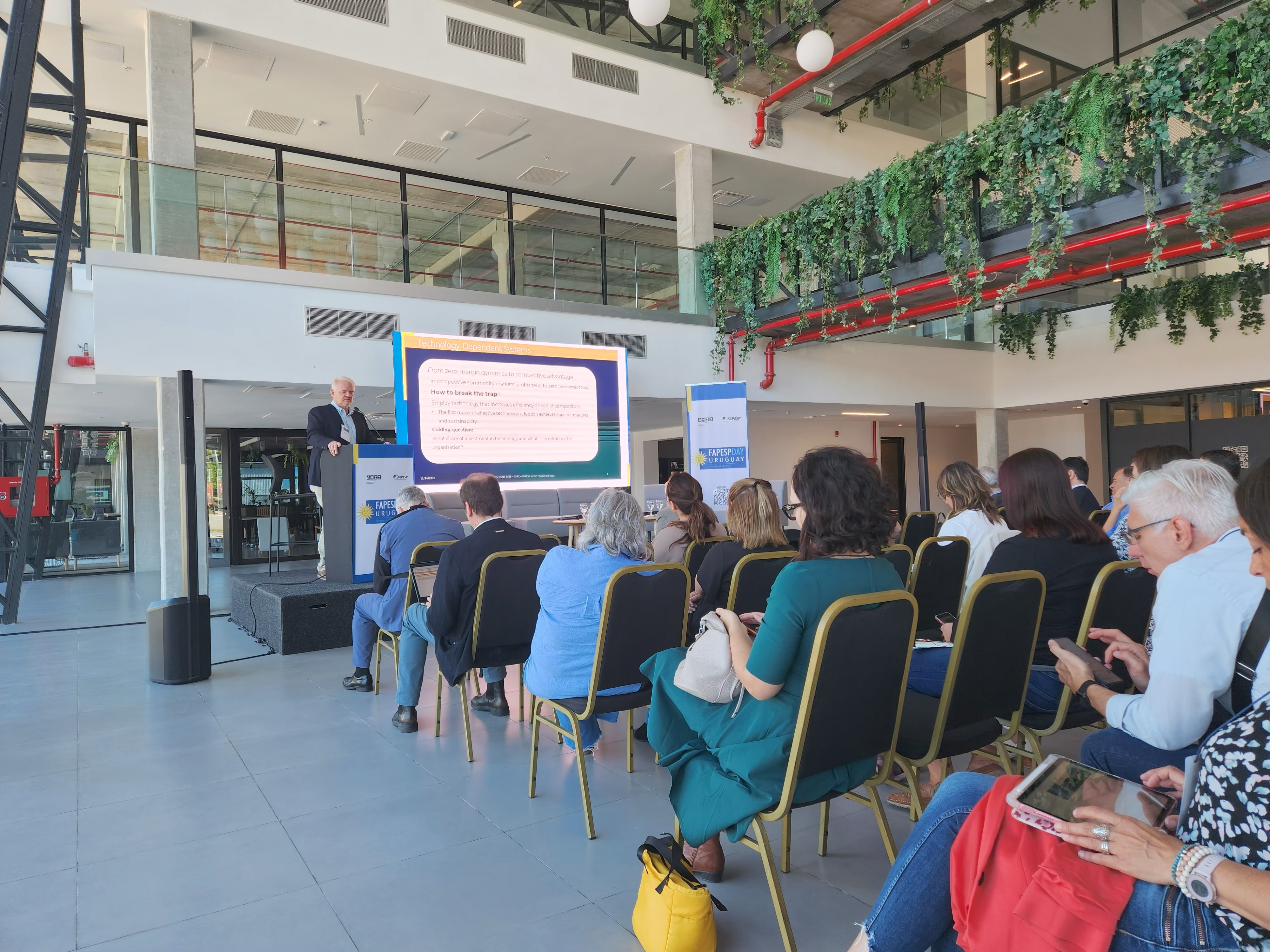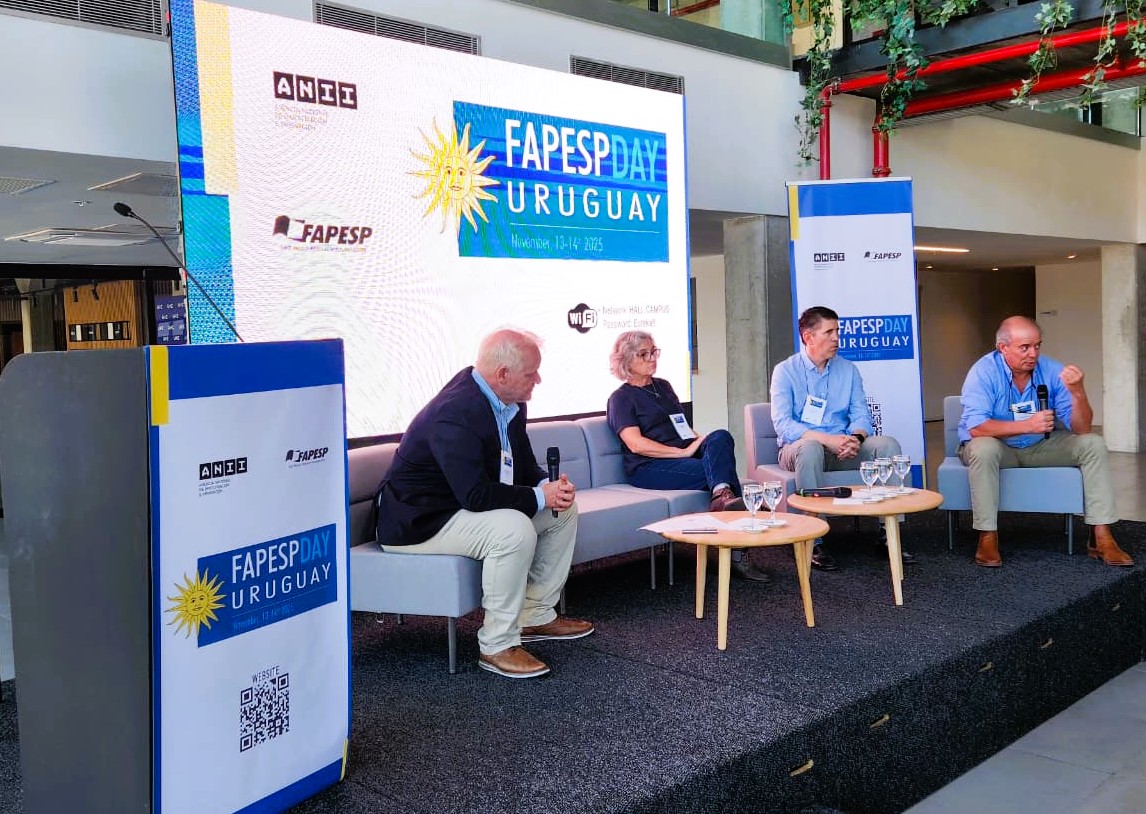


“Uruguay has one of the most efficient traceability systems in the world,” said Sérgio de Zen (photo: Karina Toledo/Agência FAPESP)
Published on 11/17/2025
By Karina Toledo, from Montevideo | Agência FAPESP – The creation of a new FAPESP Applied Research Center (ARC) in the field of animal protein production is being coordinated by researchers from the University of São Paulo (USP) and Minerva Foods, a leading South American beef exporter. The goal is to develop new technologies that will reduce costs throughout the production chain and make the process more sustainable.
Details of the project, entitled the Animal Protein Research Center – OneBeef, were presented by Luiz de Queiroz College of Agriculture (ESALQ-USP) professor Sérgio de Zen on November 14 during the FAPESP Day Uruguay symposium.
“We analyzed many research centers around the world and observed that they’re dedicated to studying only one specific sector of the production system. One does research on pasture, another studies meat processing, and another, packaging. We intend to unify them. To create a center where one link in the chain communicates with another, where studies are linked to each other, to maximize the final result,” de Zen told Agência FAPESP.
Still under review by the Scientific Board, the project calls for an investment of USD 20 million over five years – half from FAPESP and half from the partner company. According to de Zen, the goal is to transform the center into a permanent research structure by the end of the funding period. To date, the group has 96 researchers from various countries.
“Within the [Minerva] organization, we map out the major problems that require a set of research projects to solve. If we solve 5% of them, for example, and gain five days of shelf life for the meat, that alone will pay for the entire project. Why? Because it’s a very perishable, very delicate product,” he said.
Another example of a topic to be addressed is traceability, which guarantees the origin of the meat that reaches the market. “Through chemical analysis, we can determine which minerals are present in the product and compare them with what’s in the soil [where the animals were raised]. What’s in the soil reaches the plant and, consequently, reaches the animal. The type of ore I find in the Amazon is different from what exists in the South and other regions,” he explained.
During his presentation, de Zen expressed great interest in collaborating with researchers from Uruguay, a country with one of the most efficient traceability systems in the world, according to the scientist. “This can serve as a benchmark for us. Additionally, Uruguay has a wide range of data on meat production, industry, and marketing. We don’t have that in Brazil,” he said.
Animal improvement
During the same scientific session on “Strategies and policies for sustainable animal protein production,” researcher Luciana Regitano from the Brazilian Agricultural Research Company (EMBRAPA) presented data from a Thematic Project that sought to assess how the intestinal microbiota of Nelore cattle affects the animal’s feed efficiency (the ability to utilize energy from food) and methane emissions.
“To evaluate the microbiota, we collected rumen and fecal samples, initially from 52 animals raised for experimental purposes. This was a unique feature of the project. Until then, published studies had only analyzed rumen samples, which are more difficult to collect because the process is invasive. We showed that it’s possible to perform this analysis using feces,” said Regitano.
Since the group’s proposal was to use this type of analysis for animal improvement – selecting cattle that gain weight more easily and emit less methane – it was necessary to expand the sampling scale. “That’s why it was important to find a simpler way to access the microbiota,” the researcher explained.
To date, the new fecal assessment technique has been used on 640 animals raised for commercial purposes. Based on metabolomic (analysis of the set of metabolites present in feces) and metagenomic (sequencing of all RNA and DNA present in the samples, which allows the identification of microorganisms) analyses, the group identified a series of markers that can be useful in predicting whether an animal will emit more or less methane or gain more or less fat, for example (read more at agencia.fapesp.br/40007).
Additionally, hundreds of previously unknown species of microorganisms were identified. This information is all available in an online database and can be used as a resource for new studies in the field.
“In a study that’s about to be published, we catalogued all the genes expressed in the microorganisms present in the rumen of Nelore cattle. We showed that the level of expression of each gene changes the animal’s phenotype,” said Regitano. “We identified enzymes associated with both feed efficiency and methane emissions. This opens up a range of possibilities for the production of bioproducts.”
One of these possibilities, according to the researcher, is manipulating the animals’ microbiota by administering prebiotics, which are substances that feed the microorganisms in the intestine. “We identified substrates, such as peanut meal, that stimulate the production of the enzyme that reduces methane emissions.”
Another possibility is cloning the DNA sequence of the target enzymes and producing the molecules in a laboratory to administer as a supplement to the animal or treat the feed. “There’s also the prospect of expressing cellulose-degrading enzymes found in bovine microbiota, which could be useful for producing second-generation ethanol, for example,” she revealed.
The group is currently investigating how the composition of the microbiota affects the animal’s reactivity – i.e., how agitated and nervous it is. “Microorganisms produce neurotransmitters that act on the bovine nervous system. This is the most obvious connection, but there are other indirect factors that we’re investigating.”
The scientific session on animal protein production was also attended by Fabio Montossi from Uruguay’s National Agricultural Research Institute (INIA) and Federico Garcia from the University of the Republic (UdelaR).
“Montossi is interested in studying the effect of different pastures on microbiota composition and could be a potential collaborator,” said Regitano. “I also made contact with two other researchers present at the event. It was very productive.”

Sérgio de Zen, Luciana Regitano, Federico Garcia and Fabio Montossi (photo: Karina Toledo/Agência FAPESP)
More information is available at fapesp.br/week/2025/uruguay.
Source: https://agencia.fapesp.br/56492